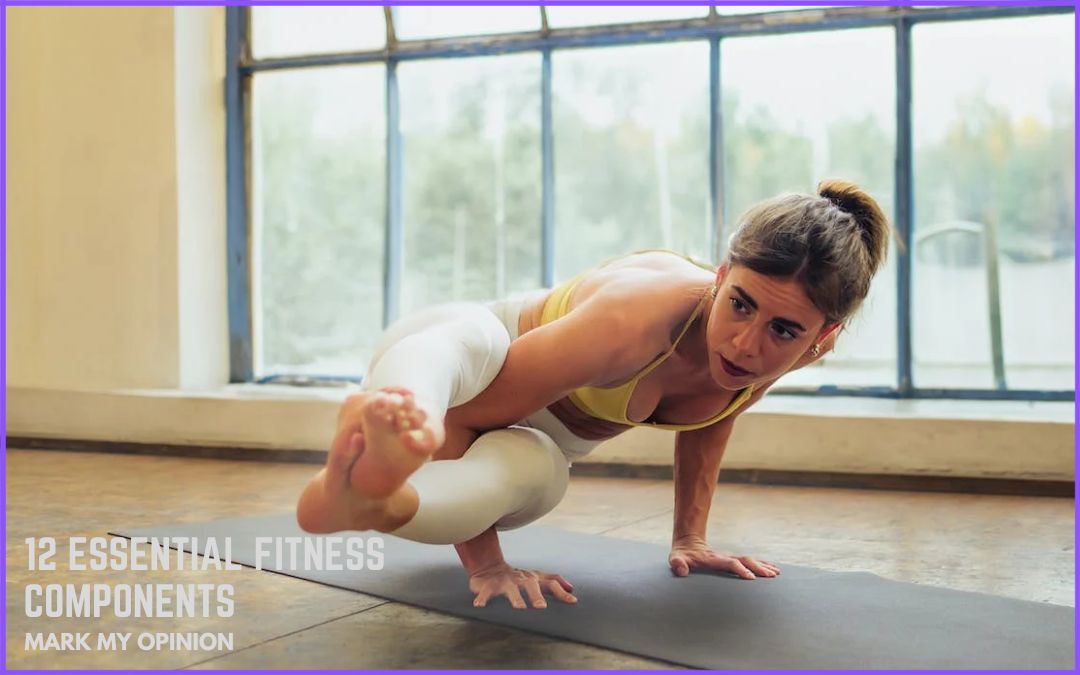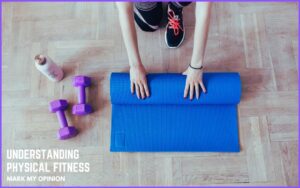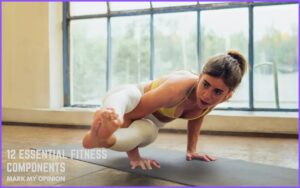Welcome to our comprehensive guide to the 12 most critical aspects of physical wellbeing! Whether you are a seasoned exerciser or just starting out, you must understand these factors in order to achieve your health and performance goals. This blog will describe each factor in detail so that you understand how they affect your fitness. We’ll also go over how to assess your fitness level and enhance your muscle strength, cardiovascular endurance, and body fat. Start this exciting exercise journey right immediately if you want to reach your maximum potential!
Understanding the 12 Components of Physical Fitness
Fitness entails more than simply decreasing weight. For maximum health and fitness, the National Federation of Professional Trainers (NFPT) suggests 12 exercise categories.
The ability of the heart, lungs, and circulatory system to give oxygen and nutrition to the body throughout extended activity is referred to as cardiovascular endurance. Aerobic dance, cycling, walking, and circuit training all benefit from it.
Muscular strength is the amount of force that a muscle or group of muscles can generate in a single motion. Resistance exercise and weightlifting can help with this. Muscular endurance refers to a muscle’s or group of muscles’ capacity to contract and relax repeatedly. Exercise and circuit training can be useful.
Flexibility improves balance, posture, and the risk of injury. Yoga and Pilates, for example, can help you become more flexible. A person’s body composition is made up of fat, muscle, bone, and other organs. Physical fitness is essential for overall health. A healthy diet and regular exercise can help with this.
Power is defined as the rapid generation of force by combining strength and speed. Plyometric and Olympic gymnastics can help you get stronger.
Speed is described as the ability to move quickly. Sprinting and circuit exercise increase metabolic rate. People who are fast to modify their thoughts are more likely to succeed. Sport-specific training and practice can assist you in increasing your speed. Balance implies maintaining equilibrium while walking, standing, or performing other actions. Yoga and tai chi help with balance.
Coordination is the capacity to employ different parts of the body smoothly and effectively. More movement increases coordination. Response time refers to the ability to react quickly. Sports-specific training and reaction practice improve reaction time.
Finally, mental and emotional well-being are critical components of physical fitness. Meditation and stress management can help with weight loss.
Testing and Evaluating Your Physical Fitness
Fitness enthusiasts who want to track their development and make sound training selections must test and evaluate their fitness levels on a regular basis. Over 40 chronic diseases, including cancer, diabetes, heart disease, obesity, high blood pressure, and diabetes, can be avoided with exercise.
Endurance, strength, balance, and flexibility, as well as BMI, are used to assess fitness. A BMI that simply considers height and weight is less accurate than a body composition test that considers fat.
Fitness and endurance can be measured. This symbolizes the health of the heart, lungs, and circulatory system. The VO2 Max Test calculates how much oxygen your body needs during severe exercise. This assessment is carried out by professionals such as exercise scientists and trainers who use advanced equipment. Before taking this test, talk to your doctor about your heart health.
Step tests are less complicated forms of cardiovascular power testing. Using a 12-inch step, time your steps on and off the block. This exam assesses the heart and lungs’ fitness.
Regularly testing and assessing your fitness levels allows you to track your progress and alter your program. When it comes to fitness, everyone has different goals and beginning places. A fitness trainer can assess your results and provide a plan based on them.
Strategies for Improving Muscular Strength and Endurance
Weightlifting, also known as resistance training, can aid in weight loss. This training approach involves straining a muscle or set of muscles against a stimulus to improve strength. A gym or fitness centre may provide resistance training with weight machines. During exercises, resistance bands or tubes might be used. Push-ups and sit-ups can be performed using only your body weight.
You don’t need a gym or workout equipment to grow stronger, more robust muscles. Daily actions such as carrying groceries or climbing stairs can cause muscle tension. You may easily and efficiently build your strength and endurance by performing these workouts on a daily basis.
Weightlifting sessions require appropriate technique regardless of method. The proper form and strategy will boost the workout’s effectiveness while decreasing the chance of injury. If you are unsure how to do something, seek the advice of a fitness expert or trainer. They can show good technique.
These approaches can help you increase muscle and stamina. As a result of your efforts, you will lose weight, gain bone and muscular strength, and feel more confident and accomplished. The most successful ways for building long-term fitness are consistency and the incorporation of more demanding workouts.
Enhancing Cardiovascular Endurance and Body Fat Composition
Improving your cardiovascular endurance and body fat composition can help you live a healthier life and lower your risk of heart disease.
Cardiovascular endurance, often known as aerobic fitness, refers to the heart’s and lungs’ ability to supply oxygen and nutrients to muscles during extended exercise. This is especially true for high-energy sports like running, swimming, and cycling. Cardiovascular endurance boosts sports performance as well as health and energy levels.
Body fat content, on the other hand, is the entire weight of your fat. Maintaining a healthy body fat percentage reduces your chances of developing heart disease, diabetes, and some obesity-related diseases. A healthy diet and regular exercise will help you lose weight and increase muscle, both of which will enhance your appearance.
Incorporating workouts into your routine will help you lose weight and improve your cardio. Cardiovascular health is improved by aerobic dance, cycling, calisthenics, circuit training, and jogging. Weightlifting and resistance training, for example, can boost metabolism and affect the way your body stores fat.
Carda Health specializes in personalized fitness suggestions, particularly after a heart attack or stroke. Our specialists can design an exercise program to help you achieve your cardiovascular endurance and body fat goals. By following our advice, you can enhance your health and exercise.
In summary
You should now be aware of the 12 basic components of physical fitness and how they interact to keep you healthy and fit. Checking your fitness levels may assist you in setting goals and improving. To achieve your fitness goals, you’ve been given advice on how to improve your muscle strength, endurance, cardiovascular endurance, and body fat distribution. Remember that being healthy takes a lifetime of dedication and perseverance. Remember to push yourself, stay motivated, and prioritize your fitness. This comprehensive book contains everything you need to optimize your potential and live a healthier, more active lifestyle. Best wishes on your fitness endeavour!



